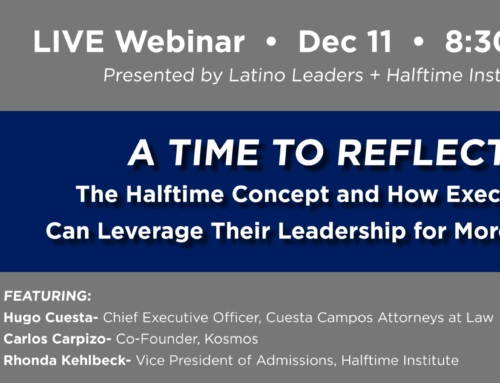While the journey of mid-life renewal is common all over the world, every person’s second half calling is somehow unique. People from all professional and personal backgrounds tend to make some common mistakes when they come to this season of mid-life renewal.
Regardless of your first half career, these three keys will significantly improve the chances of you making a smooth transition to Life II.
1. Recognize that you need renewal at mid-life, and begin working on it earlier than you think is necessary. Here’s why:
It’s hard to see it coming because we often have “life systems” finally running smoothly – but that’s precisely the time to begin renewal. Why?
- It’s very tempting to just try to keep the status quo working for another five years until we reach a certain level of financial security, or until the last kid has a stable job, gets married, etc.
- Mid-life offers the potential of renewal or crisis – waiting too long sets you up for a crisis. None of the people I have coached who found themselves in mid-life crisis planned to get there – it snuck up on them.
- At age 56, I am now entering another rigorous season of mid-life renewal. I’m moving from 20 years of speaking, writing and coaching, to a season of replication, working with fewer people who are called to carry this message in their sphere of influence. After developing expertise in these areas, it is difficult to change gears, and give up doing things that have brought so much joy. Margie Blanchard taught me that I need to create a vacuum of time and quietly wait to see how the Lord wants to fill it.
- Last night, I was out on our lake with my closest friends. A cool breeze pushed our anchored boat from side to side, full moon overhead and they asked me ‘how’s it going?’ I’m so thankful that they understand that mid-life renewal is a journey of the heart, because I found it very hard to put into words what it’s like to let go of what you have clearly been created to do for many years. Does your heart resonate with any of that?
2. Get clear on your mission and metrics.
- These seemingly corporate words will bring to your second half a little of the rigor that has enabled you to succeed in the first half. I wouldn’t try to run my business without a mission and metrics. It’s very hard to build a plan for your second half without a clear sense of what you want in the end, and what you feel is your purpose. The most common mistake we see people making is to work on the solution too quickly. When you begin to explore a variety of ways you could reconfigure your life without clear metrics and a personal mission, you run the risk of becoming tactics in search of a strategy. Confusion escalates. People feel “sloppy busy” – their calendar seems full but they are really not sure if it’s filled with the best things.
- Getting clear on mission and metrics requires process – you can start with the question “If my life turned out perfectly, what would the elements be?” This is a metrics question, but you have to think differently about metrics. For now, focus on what you want to be the long term priorities and outcomes of your life. Don’t worry about how you would measure those, that will become obvious over time.
3. Don’t try it alone.
- Peter Drucker wisely told us, “smart people need a safe place among peers, to think their confusion out loud.” I’ve learned that he was right – it’s the secret sauce. You need some people around you in this confusing season of mid-life renewal – they bring the required encouragement, perspective, and a place where you can talk about it and gain clarity as you do. That’s why we work hard to provide people with not only a small group of peers, but also the right setting and process to share with each other.
- Work intentionally to build alignment with your spouse if you are married – this is an opportunity to go from writing two separate stories to creating a common narrative together. It’s an opportunity to move toward deeper intimacy which will bring more joy into your second half. Linda and I have interacted with many couples at this season, and share what we have learned in our free eBook Halftime for Couples. Alignment with one’s spouse is one of the key aspects we touch on in the Halftime Fellows Program because we’ve learned after 20 years of helping people through the halftime journey that you can’t finish well if you’re homefront is a mess.
- Make it a family affair – your adult children will bring surprising wisdom and perspective if you have the courage to share your emerging plan with them. By including them, they will learn how a talented leader allows God to redirect them and renew them after a long season of work and focus. And, building a thriving family after the kids are grown up is different than raising a family – so it involves different questions. Questions like:
- What’s the difference between a healthy family and a thriving family?
- What’s our vision for our family in our second half?
- What is my role in the family now that they are in college or on their own?
- My role in the family when the kids were little was teaching them character and obedience. When they were teenagers, it was teaching them responsibility. But now that they are 30, 29, 28 and 25 my role has shifted to more of a strategic coach.
Through thousands of years of history, as people have aged they have moved from warrior, when they are young, to king in mid-life, to sage in their second half. Each season has its own joys and challenges. But trying to hold onto the warrior or king role too long is costly. There is something so satisfying about graciously and humbly moving into the next season, bringing the wisdom and perspective that you can only gain with experience.
Get started by asking yourself:
- What triggers do you see in your life that indicate you may be at a season of renewal?
- What will you need to let go of to create the vacuum? or margin?
- What do you need to help you get clear on mission and metrics?
- How will you include those around you in the journey?






